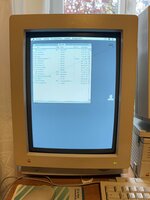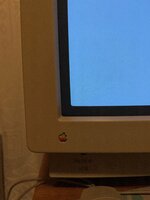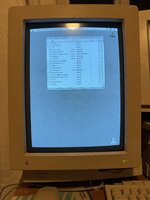Not sure where to place this (mods let me know if its fine here, else I can move it  )
)
The Apple Portrait Display, released in 1989, was a groundbreaking monitor that broke away from the conventional 4:3 aspect ratio of its time. Designed with productivity in mind, it featured a tall 15-inch grayscale screen with a unique 640x870 resolution with a refresh rate of 75Hz!, ideal for displaying entire pages of text or layouts without scrolling. This made it a favorite for desktop publishing, word processing, and other professional tasks requiring precise attention to detail.
Compatible primarily with Macintosh computers, the Portrait Display utilized Apple's innovative QuickDraw graphics technology to render crisp, detailed images and text. It connected via the Macintosh II series’ proprietary video cards and became a hallmark of Apple's commitment to design and functionality tailored to specific user needs.
The Apple Portrait Display remains a fascinating piece of computing history, exemplifying Apple's early efforts to cater to creative professionals. Its striking form factor and focus on vertical workspace set a precedent for modern portrait-oriented screens and remain an iconic reminder of a time when Apple pushed the boundaries of hardware design. More info can be found here https://lowendmac.com/1989/macintosh-portrait-display/
I created a small video on what it contains inside, how to recap it (it has LOTS of caps) and how to set the geometry adjustments. hope you enjoy it!
Important links:
* Display Service Utility
https://macintoshgarden.org/apps/disp...
* Portrait display capacitor list (NOTE: use it as a reference but be weary that you need 105c rated caps instead of 85c ones on the neck and sweep boards)
https://tinkerdifferent.com/threads/m...
The Apple Portrait Display, released in 1989, was a groundbreaking monitor that broke away from the conventional 4:3 aspect ratio of its time. Designed with productivity in mind, it featured a tall 15-inch grayscale screen with a unique 640x870 resolution with a refresh rate of 75Hz!, ideal for displaying entire pages of text or layouts without scrolling. This made it a favorite for desktop publishing, word processing, and other professional tasks requiring precise attention to detail.
Compatible primarily with Macintosh computers, the Portrait Display utilized Apple's innovative QuickDraw graphics technology to render crisp, detailed images and text. It connected via the Macintosh II series’ proprietary video cards and became a hallmark of Apple's commitment to design and functionality tailored to specific user needs.
The Apple Portrait Display remains a fascinating piece of computing history, exemplifying Apple's early efforts to cater to creative professionals. Its striking form factor and focus on vertical workspace set a precedent for modern portrait-oriented screens and remain an iconic reminder of a time when Apple pushed the boundaries of hardware design. More info can be found here https://lowendmac.com/1989/macintosh-portrait-display/
I created a small video on what it contains inside, how to recap it (it has LOTS of caps) and how to set the geometry adjustments. hope you enjoy it!
Important links:
* Display Service Utility
https://macintoshgarden.org/apps/disp...
* Portrait display capacitor list (NOTE: use it as a reference but be weary that you need 105c rated caps instead of 85c ones on the neck and sweep boards)
https://tinkerdifferent.com/threads/m...



